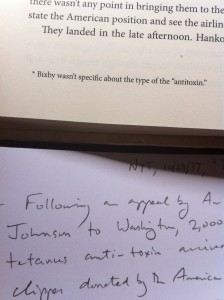Even though the book is published and released in the world, a few lingering China’s Wings questions continue to haunt me…

I’m well aware that it’s a minute detail, but one of those lingering uncertainties can be found at the bottom of China’s Wings page 116, in a footnote in which I confess to not knowing what type of “antitoxin” Eurasia was flying from Hong Kong to Hankow on October 25, 1937. William Bond and Harold Bixby were aboard the flight, which Harold Bixby described in exquisite detail in a letter he wrote to his family on October 26, 1937. From that letter, I know that Eurasia flew the medicine free of charge, and Pan Am had flown the medicine across the Pacific the week before, also gratis, but unfortunately for the obsessive corner of my mind, Bixby didn’t specify exactly what type of medicine was aboard the plane, nor who was its intended recipient after U.S. Ambassador to China Nelson T. Johnson, and that uncertainty has nagged at me for five or six years.
Well, now I know.
Or, perhaps better said, now I think I know.
I’ve been working on a story about the 1937 Battle of Shanghai, and while scrutinizing every mention of Shanghai in The New York Times between August 1 and December 31, 1937, I hit upon the answer — or what I think is the answer.
In an article titled “Defense Improved” in the October 28, 1937 issue of The New York Times, correspondent Hallett Abend mentions that 2,000 doses of tetanus antitoxin donated by the American Red Cross and consigned to U.S. Ambassador Johnson had recently arrived in Shanghai after being flown across the Pacific on a Pan Am Clipper. Chinese gratitude for the donation was mentioned in “Chinese Thank U.S. For Medical Help,” which appeared in the newspaper three days later.
It strikes me as most likely that the drugs mentioned in those articles are the same ones that Bixby mentioned in his letter written just two days before.
The tetanus antitoxin was used to treat Chinese soldiers wounded in the Battle of Shanghai.
Phew…

